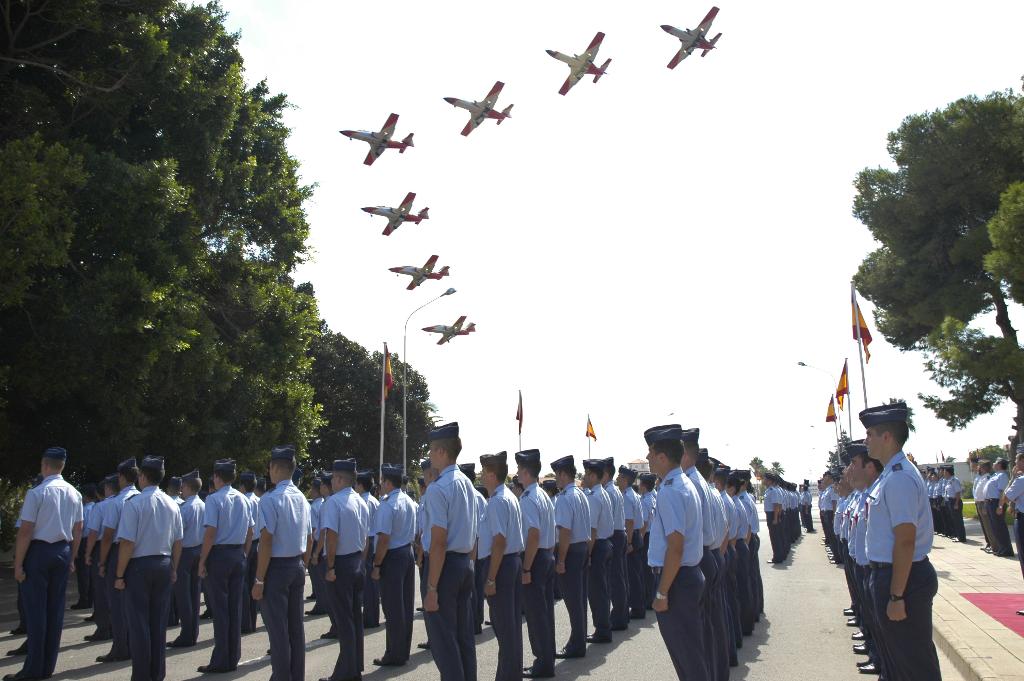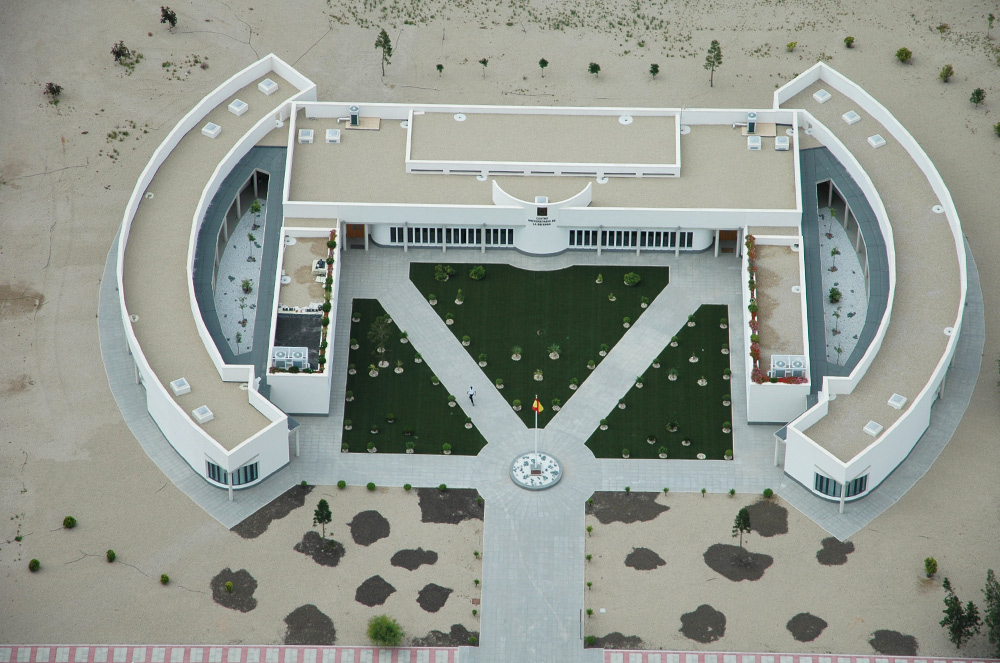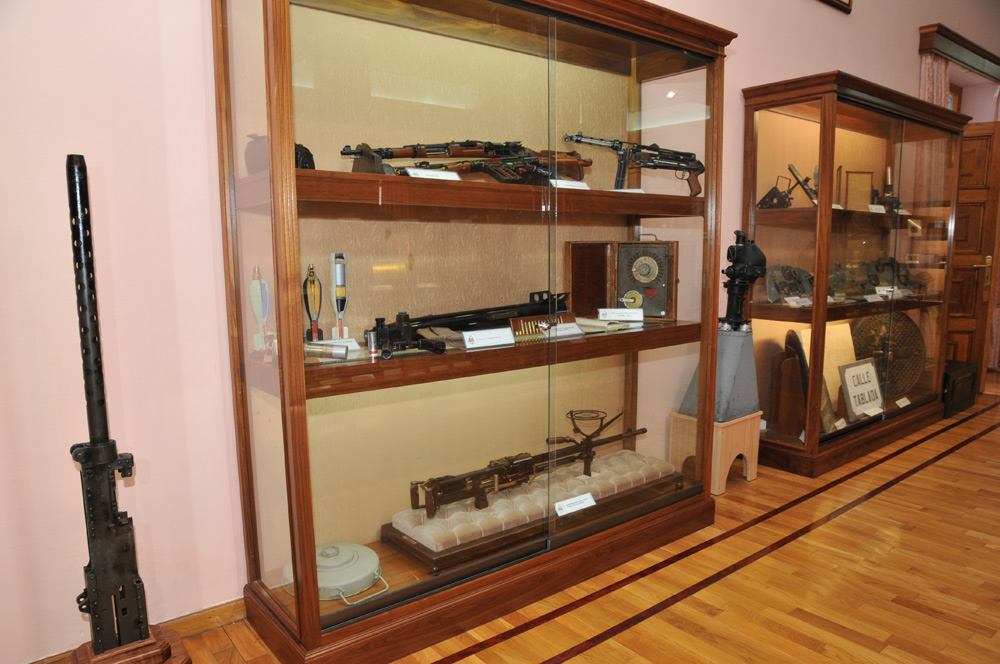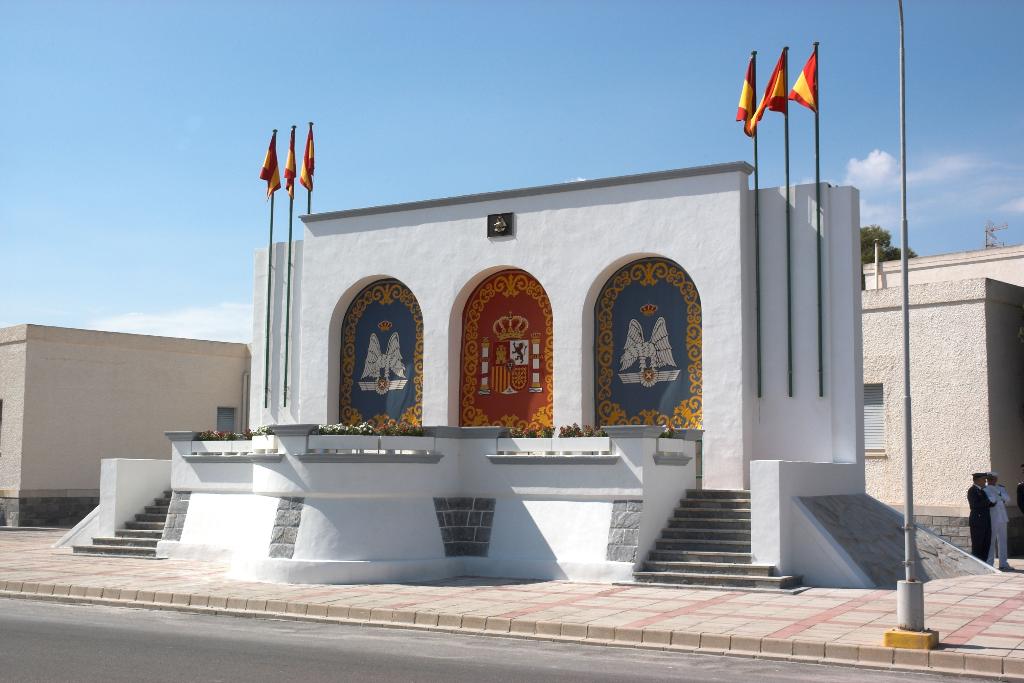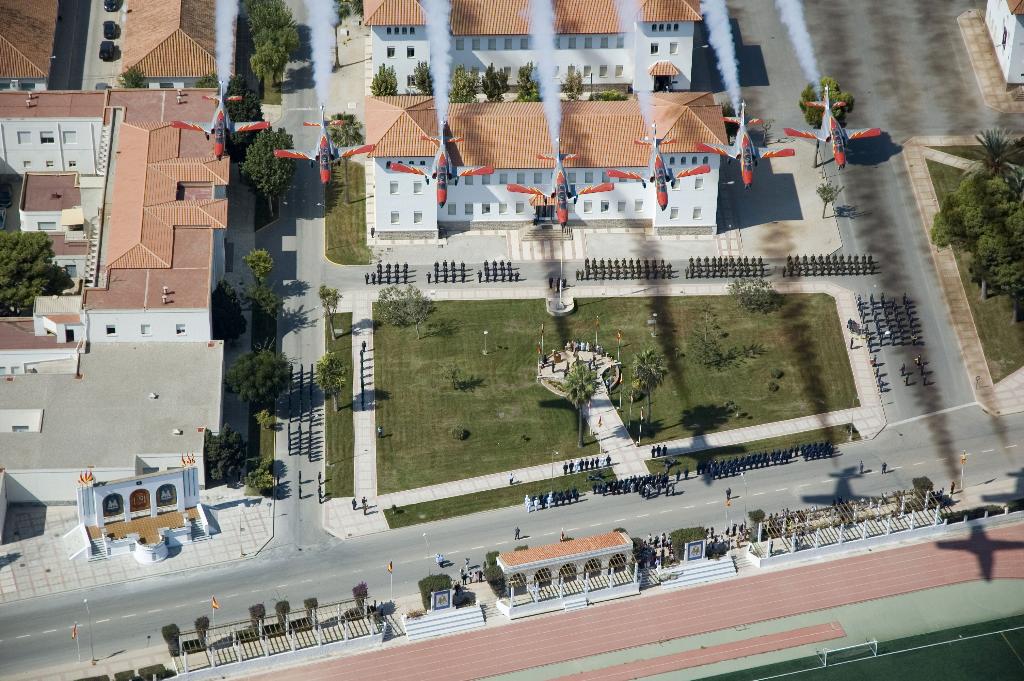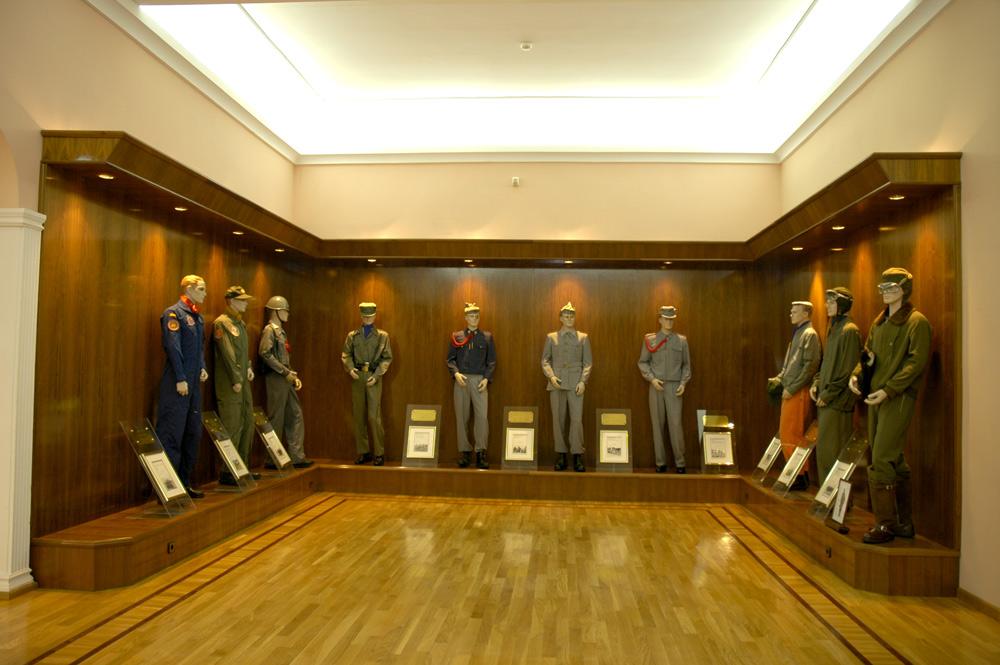Academia General del Aire
C/ Maestre
SANTIAGO DE LA RIBERA (SAN JAVIER)
Telephone: 968189000
http://ejercitodelaire.defensa.gob.es/
GENERAL AIR FORCE ACADEMY
Spanish Air Force training centre and headquarters of the famous Águila patrol.
One of the big days, and in which there is a live show of the Patrol’s stunts, is on the 25th of July during Santiago Apostle festivities, as well as during the appointment of the new officers that takes place every year in the month of July.
C/ Maestre, Santiago de la Ribera
Date of creation: 1926
In its initial stage, the San Javier airfield served as a naval air base, hosting, among other units, several schools of Naval Aeronautics.Therefore, this facility has been closely tied to aeronautical education from its origins. The Naval Aeronautics also constructed most of the hangars and buildings at the San Javier Base, giving it its current appearance, which has scarcely changed over time.
During the Spanish Civil War in 1936/39, the San Javier Aeronautics Base became part of the Spanish Republic Air Force. Given its facilities and position, at rear guard, its main mission then was flight training, becoming one of the main cores of the republican air force together with the nearby aerodrome in Los Alcázares.
After the end of the Civil War, the San Javier Base became part of the newly crated Air Force. In this new stage, its main mission was flight training once again, leading to the establishment of the Aerial Premilitary School which trained auxiliary pilots, with the first promotion consisting of 400 students in 1940. The San Javier School was part of the Levante Schools Group, which included the elementary Schools of El Palmar and Alcantarilla, as well as Los Alcázares Airfield and various temporary fields like Carmolí.
As the Air Force developed, it became necessary to provide it with a genreal officers' academy, similar to the Army and the Navy. Thus, by decree on July 28, 1943, the General Air Academy (AGA) was established, with General Juan Vigón Suerodíaz serving as the MInister of the Air Force at that time. The mission of this new unit was to train future professional officers of the Air force in military, aeronautical, cultural, humanistic, and physical aspects.
On September 15, 1945, the first class entered the General Air Academy, with Colonel Antonio Munaiz de Brea as its first director. On december 10 of the same year, it received its first national standard donated by the Air Force and acquired through subscription among all its officers. This standard is currently preserved in the Air Museum of Cuatro Vientos.
The AGA coexisted with the Army Officers Academy in León until 1949. From then until 1989, it became the main academy of the air force and is currently the only officer tarining academy for the Air Force.
Flight traning has been the core focus of education in San Javier, consisting of two phases: an initial elementary phase followed by a perfection phase, later called basic flight. The elementrary training primarily utilized the Bucker Bu-131 biplane form Septermber 1945 to March 1976. From February 1958, the Basic Flight Squadron was established with the introduction of Beechcraft T-34 Mentor aircraft. These planes were part of the material recived through friendship agreements with the United States, significantly enhancing flight training in San Javier.
The AGA also operated multi-engine aircraft for instruction in navigation, aerial photography, bombing exercises, and observer courses. Notable among these planes were the ubiquitous Junkers Ju-52, Hinkel He-111 bombers, and, following the agreements with the United States, the versatile DC-3 transport plane.
During the academic year 1958-59, His Majesty King Juan Carlos I completed his military training at the AGA, as part of the eleventh promotion. King Juan Carlos I had his first flight on Septermber 16, 1958, in the Bucker E.3B-174. He also flew the Mentor and the Junkers Ju-52, receiving the military pilot emblem on July 15, 1959.
In the 1962/63 academic year, North american T-6 aircraft were incorporated into the AGA, with the Basic Flight School relocating from Salamanca to San Javier. This aircraft remained in service until the 1981/82 academic year, when it was repalced by the casa C-101.
The defunct Basic Flight School of Matacán In Salamanca was established in 1954 as a precursor to jet training. From 1963, the AGA assumes this role, strengthening the Basic Flight Squadron with the mentioned T-6 planes.
In the 1970/71 academic year, the AGA celebrated its Silver Jubilee on July 15, 1971, coinciding with the commissioning ceremony. In the 1971/72 academic year, the AGA resumed the training of Air Force Corps aspirants, previously trained in various schools. Also, during this academic year, the Hispano HA-200 Saeta jets, the first nationally manufactured jets, were introduced and remained until the arrival of the C-101.
From the 1976/77 academic year, admission to the AGA required passing a course at the General Air Academy Selection Center (CSAGA), initially located in Granada and later in Los Alcázares from the 1980/81 academic year. This system ended with the miliarty education reform of 1986.
On April, 27, 1980, in a ceremony presided over by His Majesty the King, the National Flag was blessed and handed over to the General Air Academy. Queen Sofia was the godmother of the flat. It's worth noting that the Genral Air Academy was the first unit of the Air Force entitled to carry a flag.
His Royal Highness Prince Felipe de Borbón, part of the XLI Promotion, studied at the AGA during the 1987/88 academic year and received his lieutenant commission on July 10, 1989. His Royal Highness underwent aeronautical training in T-34 Mentor, C-101, and C-212 Aviocar aircraft.
In the 1988/89 academic year, the first woman, Cade María Eva Lequerica from Jaén, enrolled in the AGA, aspiring to the Pharmacy Corps. Since then, the proportion of female students has steadily grown, currently exceeding 10%.
The AGA celebrated its golden anniversay during the 1993/94 academic year, with the presence of Their Majesties the Kings of Spain. Rafael Mellado Pérez, an AGA official and official chronicler of San Pedro del Pinatar, published the book "General Air Academy. Chronicle of 50 yearas" for this occasion.
With the turn of the century, the AGA stands as the sole officer training academy for the Air Force, fully capable of meeting the challenges posed by technological evolution and strategic changes in the global landscape.
On March 2, 2004, a historic milestone was achieved with the Casa C-101 Aviojet surpassing 176,124 flight hours, originally set by the Bücker BÜ-131 Jungmann biplane. The AGA currently boastas over 250,000 flight hours.
In the 2006/2007 academic year, for the first time, a woman, Rosa María García-malea López, achieved the qualification for fighter and attack aircraft. The following year, Second Lieutenant Rocío González Torres achieved the hightest score in this specialty. Another significant milestone in the integration of women in the AGA occurred in the 2008/09 academic year when Lourdes Losa Calvo became the flag bearer, eventually becoming the first woman to graduate as the top student in her promotion in July 2010.
It is worth highlighting the celebration of the Aire06 Air Festival in June 2006, as part of the "Murcia nuestra Cuna" (Murcia Our Cradle), with an estimated 200,000 people attending the static exhibition and over 500,000 at the festival itself. This was facilitated by the participation of the best national and international aerial formations.It was considered the best air festival in Europe by foreign press. In June 2010, the 25th anniveresary of the Águila patrol was commemorated with an open day and air festival, featuring nearly all aircraft of the Air Force, as well as the Italian acrobatic team "Freche Tricolori", who also celebrated its 50th annivresary. These events attracted a large audience and signifcant media coverage.
The Military Career Law 39/2007 introduced a new military education model. Consequently, the Defense Univesity Center (CUD) of San Javier was created based on an affiliation agreement between the Ministry of Defense and the Polytechnic University of Cartagena. This center provides a degree in Industrial Oraganization Engineering to AGA students, in addition to traditional military and aeronautical education.
On January 25, 2008, another historic milestone was achieved as tha Casa C-101 (E.25) aircraft surpassed 200,000 flight hours, only approached by the 176,124 hours and 58 minutes of the Bücker Bü-131 Jungmann biplane.
On September 29, 2010, the official inauguraiton ceremony of the first academic year under the new education model took place. This reform is the most significant one that military education, and therefore the AGA, has undergone in its 66 years of activity. It not only adds undergraduate study programs but also expands the center's scope, now including the University Center for Defense in San Javier. Since its inception, more than 6,500 students have passed through this military training and Leadership Development institution.



